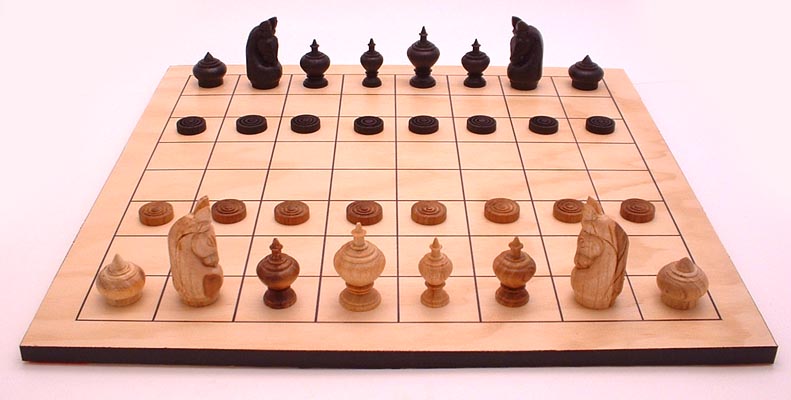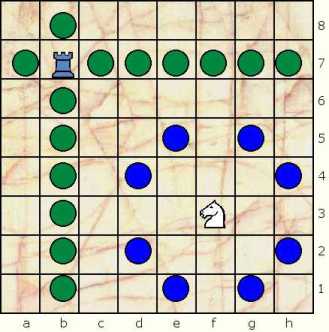Makruk (Thai chess)
This page contains one or more presets for playing a game online with Game Courier, an online server for playing Chess variants by correspondence.

Makruk is the variant of chess most played in Thailand. It is regarded as the most similar living game to the common ancestor of all chess variants: Chaturanga (very closely resembling Davidson's variation).
Makruk is a chess variant that starts off as a war game between two sides with equal material, but which later on (in the end-game) incorporates concepts of pursuit and escape games (like Hnefatafl); as one player (the disadvantaged-side) becomes the defender and his/her goal turns from pursuing to checkmate, into escaping from a checkmate by the stronger side (the attacker), by means of special counting rules that aim to force a draw to end the pursuit.
Makruk Game Presets



Makruk Preset 1 with Alfaerie version of Japanese Silver Generals for the Thai Bishops
Makruk Preset 2 with Burmese Elephants for the Thai Bishops, White and Black pieces (or with Red and Black pieces)
Makruk Preset 3 with western chess pieces, upside down Queens and Bishops (the pieces with non-orthodox movement). Upside down Pawns for Promoted Pawns (Biagai) are available.
(the Promoted Pawns at a5 and a4 displayed in the Preset will be removed once the game begins)
New! Test Makruk Preset 2 and Test Makruk Preset 3 (Red and Black pieces) that enforce the rules (except for the Draw Counting rules)
Setup

The opening setup is very similar to that of orthodox chess, with the following differences: the positions of white king and queen are reversed, and all pawns are on the third and sixth row. So, the setup is as follows:
White:
King d1; Queen e1; Rook a1, h1; Knight b1, g1; Bishop c1, f1
Pawns: a3, b3, c3, d3, e3, f3, g3, h3
Black:
King d8; Queen e8; Rook a8, h8; Knight b8, g8; Bishop c8, f8
Pawns: a6, b6, c6, d6, e6, f6, g6, h6
Pieces
The Thai King (Khun) moves like in orthodox chess, one square in any direction. The Thai Queen (Met) on the other hand, is a lot less powerful that it's orthodox chess counterpart. In Makruk the Queen moves like Chaturanga Counselors as a Ferz, only one square diagonally.
The Thai Bishop (Khon or Thon) moves one square either diagonally or straight forward. Both Burmese Chess (Sittuyin) Elephants (Sin) or Japanese Chess (Shogi) Silver Generals (Ginsho) move as Siamese Bishops and are valid piece equivalents. The 5 dots on the Alfaerie Shogi piece indicate the movement of a Silver General and the moon is the alchemy symbol for silver.

Thai Rooks (Rua [Boat]) and Knights (Ma [Horse]) move identically to their Orthodox Chess counterparts. The Knight is the only piece capable of jumping over other friendly or enemy pieces.

Thai Pawns (Bia [Cowry Shells]) move and capture just like their Orthodox Chess counterparts; one step foward for movement and diagonally to capture. Pawns start up on their 3rd rank and do not have a 2-step initial move, consequently there is no en passant rule. Pawns promote upon reaching their 6th rank. Promoted Pawns (Biagai [Promoted Cowry]) move like a Met (Queen, one step diagonally forward or backwards). In the example below the h-pawn can move to h6 (or capture at i6) and promote to a Queen.

Rules
Objectives of the game
For the stronger side, to checkmate the opponent's King.At the beginning of the game, since both sides are even in material, they both aim to checkmate the opponent to win the War (game).
Later on (as the result of the opening, middle-game and early end-game sections of the game) the player with the material advantage becomes the stronger side and is still aiming for checkmate.
However (later in the end-game) the game turns from a War game into a Pursuit and Escape game, where the weaker side's objective is to force a draw by means of special Thai counting rules.
Draws in Makruk
Many games of makruk end in draws. This is because late in the game, the concepts of pursuit and escape become very important in Makruk.There are special counting rules in the endgame which permit the disadvantaged side (the escaper) to claim a draw against the pursuer (the stronger side).
A stalemate is a draw in Makruk.
Draws can also take place by agreement of both players, as in Orthodox Chess.
Draw Counting Rules
Counting Rule #1: Pawnless Games - The Board's Honor Rule
When neither side has any unpromoted pawns left on the board, the game must be finished within 64 moves, or it is declared a draw.The player in disadvantage counts the moves up to 64 (the number of squares on the board), and is allowed to stop counting if he or she no longer feels at disadvantage.
If the player at a disadvantage is able to make the 65th move without been checkmated, the game is a draw.
If the disadvantaged side checkmates the stronger side and did not stop counting, the game is declared a draw.
The count does not restart unless the disadvantaged side had stopped counting and would like to start counting again.
The count is not restarted when the side at disadvantage performs a capture.
Counting Rule #2: Bare King - The Pieces' Honor Rule
When one side is left with a bare or lone king (right after his last piece is captured), the counting is restarted.This time, the count required to mate is calculated in a special way based on the material available to the stronger side, and the number of pieces left on the board.
First, find the number of total moves required to mate based on the material available to the stronger side from the table below (select the first one that applies):
| Material (Pieces) Left: | Moves required to mate |
|---|---|
| at least two rooks (rua) | 8 |
| at least one rook (rua) | 16 |
| at least two bishops (khon) | 22 |
| at least two knights (ma) | 32 |
| at least one bishop (khon) | 44 |
| any other combination: | 64 |
| at least one knight (ma) | " |
| queens (met) and/or pawns (bia) | " |
Second, substract from the number of moves above the number of ALL pieces left on the board (both sides). This is the new number of moves required to mate, before the game is declared a draw.
For example, if a side has king, two rooks and knight versus a lone king, the stronger side must deliver mate in 8 (two rooks) - 5 (five pieces) = 3 moves, or the game is declared draw. The count would start at 6 (5 pieces + 1) and goes to 8; or alternately from 1 to 3.
If a side has king, bishop, two queens and a pawn versus lone king, the stronger side has 44 (at least one bishop) - 6 (six pieces) = 38 moves to deliver mate, before a draw is called. The count would start at 7 (6 pieces + 1) and goes to 44; or alternately from 1 to 38.
Unlike the 50-move rule in orthodox chess, in Makruk the count does not restart if the bare King performs a capture.
Point of clarification: The count under the Bare King - The Pieces' Honor Rule is restarted regardless of any current running count under the Pawnless Games - The Board's Honor Rule. Therefore it is possible for the new count to reach under the Bare King rule to be higher or lower, than the previous running count under the Pawnless Games rule, which is totally scratched.
Notes
Homemade Makruk Sets
Original set on the left built by Gary Gifford, composed set on the right by Jose Carrillo.
The Carrillo set uses the Kings, Knights and Rooks from a standard chess set; homemade Prime Ministers as Chaturanga Counselors for the Thai Queens; Seirawan Elephants as Burmese Elephants for the Siamese Bishops; and Checkers (Draughts) men for the Makruk Pawns.
The Pawns are smooth on one side, and decorated with concentric rings on the other side to represent promoted pawns (biagai).
Another homemade sculptured Makruk set by Gary Gifford.
Pocket flat magnetic Orthodox Chess composed Makruk set
Set composed by Jose Carrillo. Upside down Queens and Bishops for pieces with non-orthodox movement. Upside down Pawns represent promoted pawns (i.e. pawn at h4 in sample mate position at right). This set inspired the 3rd Game Courier Makruk Preset above.
Abstract Makruk sets
Cambodian Makruk pieces

Makruk in the West in action!
Game Courier Logs
Game Courier Logs for Games of Makruk (Thai chess)To see actual games that have been played on-line in the CV Game Courier, follow the link above.
Makruk Ratings on the Chess Variants Game Courier
Makruk Ratings on the Chess Variants Game CourierMakruk Games Library
Library of a collection of some Makruk games played in the InternetOther Makruk (Thai Chess) links in the net:
- Makruk and Ouk Chratang - Paperback Book by Gary Gifford (2010)
- How to play Thai Chess
- Makruk - Wikipedia
- Makruk - SchemingMind Wiki
- Ouk Chatrang and Makruk
- How to play Thai Chess - by Ancient Chess.com
- Makruk Rules Booklet - by Ancient Chess.com
Chess Variants by the Author:
- Modern Chess Complex
- Modern Random Chess (9x9)
- Contemporary Random Chess (8x8)
- Prime Ministers Chess (9x8)
- Pseudo-Modern Random Chess (9x9)
- Chess8400 (9x9)
- Prime Ministers Contemporary Random Chess (8x8)
- Prime Ministers Random Chess (9x8)
- Hia Chess (9x8)
- Modern Capablanca Random Chess (10x8)
- English Chess Complex
- Modern English Random Chess (10x10)
- International Contemporary Random Chess (10x10)
- International Fischer Random Chess (10x10)
- Courier Chess Complex
- Courier Chess Moderno (12x8)
- Mini Courier Chess Moderno (10x8)
- Silver Elephant Chess (10x8)
- Modern Ministers Courier Chess (11x8)
- Ajax Complex
- Ajax Chess (10x10)
- Ajax Orthodox Chess (8x8)
- Ajax Random Chess (8x8)
- Ajax Modern Random Chess (9x9)
- Ajax Ministers Chess (10x8)
- Ajax Falcon Chess (10x8)
- Ajax-Capablanca Chess (10x8)
- Korean Random Chess (9x10)
- Latrunculi XXI (10x8)
- Petteia XXI (8x8)
- Partnership Chaturanga (8x8)
Other Presets by the Author:
- Chaturanga - Davidson Variation on an original Indian ashtapada board (or on an uncheckered plain board)
- Modern Chess Preset
- Fischer Random Chess Preset
- Makruk (Thai Chess) Preset
- Modern Shatranj Preset
- Ajax Xiangqi (9x10) proposed by Charles Gilman
- Ajax Bigamous Chess (9x8) by Carlos Cetina
- Ajax Euchess (10x10) by Carlos Cetina
- Frolov Chess - Ajax Variation (9x9)
- Hiashatar (Mongolian Decimal Chess) (10x10)
- Milenium 3D Chess (8x8x3) by William L. D'Agostino
Other Pages by the Author:
- How to Generate Random Positions
- The Bishop Adjustment Rule
- The Modern Principles
- Reverse Symmetry
- The Prime Minister
- The Courier Elephant
- The 10x8 Variants
- Checkers Variants
 This 'user submitted' page is a collaboration between the posting user and the Chess Variant Pages. Registered contributors to the Chess Variant Pages have the ability to post their own works, subject to review and editing by the Chess Variant Pages Editorial Staff.
This 'user submitted' page is a collaboration between the posting user and the Chess Variant Pages. Registered contributors to the Chess Variant Pages have the ability to post their own works, subject to review and editing by the Chess Variant Pages Editorial Staff.
Author: Jose Carrillo.
Web page created: 2008-07-03. Web page last updated: 2016-12-29
